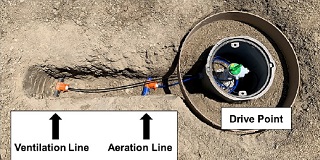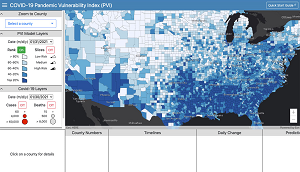Hot Off the Press
Research Briefs

- Modeling and Field Tests Yield Promising Results for Aquifer Clean Up : NIEHS Superfund Research Program (SRP) grantees have developed novel, slow-release oxidant-paraffin candles that dissolve and degrade chlorinated contaminants in underground aquifers. The grant recipient, small business AirLift Environmental, worked with partners at the University of Nebraska-Lincoln (UNL) to optimize this groundwater clean-up method and demonstrated its effectiveness in a field study.
- Triclosan and a High-fat Diet Worsen Liver Disease in Mice : A new study funded by SRP shows triclosan exposure, in combination with a high-fat diet, can worsen nonalcoholic fatty liver disease. Led by Robert Tukey, Ph.D., researchers at the University of California San Diego SRP Center described the molecular mechanisms by which triclosan alters metabolism and gut microbiota, resulting in fat buildup in the liver.
- New Model to Examine PFAS Sheds Light on Lipid Disruption Mechanisms : Researchers from the Boston University (BU) Superfund Research Program (SRP) Center developed a novel study design that generated new insight on the effects of perfluorooctanoic acid (PFOA) on cholesterol regulation in the liver. Led by Jennifer Schlezinger, Ph.D., the team also investigated the molecular mechanisms of action, focusing on effects of PFOA on the human peroxisome proliferator activated receptor α (hPPARα), a transcription factor that regulates lipid homeostasis.
- Improved Sequencing Method Leads to Advancments in Toxicology Research : NIEHS-funded Superfund Research Program (SRP) scientists are employing a new RNA sequencing method to assess mechanisms of toxicity on a finer and more accessible scale. Researchers in SRP grantee Tim Zacharewski's Lab at the Michigan State University (MSU) SRP Center conducted the study.
Environmental Factor Articles
- Extramural Paper of the Month: New graphene nanochannel filters hold promise for contaminant clean-up : A new strategy to design nanomaterials to better filter contaminants from water overcomes previous limitations, according to Brown University SRP researchers.
- Superfund Wetterhahn Award goes to Jennifer Kay : On Dec. 14, during the SRP Annual Meeting, Jennifer Kay, Ph.D., was named the 23rd winner of the Karen Wetterhahn Memorial Award. Kay studies how genetic factors affect susceptibility to mutations and cancer following exposure to N-nitrosodimethylamine (NDMA). That compound is one contaminant found at the Olin Chemical Superfund Site in Wilmington, Massachusetts.
- Triclosan worsens fatty liver disease in mice : NIEHS-funded researchers at the University of California (UC) San Diego found evidence that triclosan - an antimicrobial found in medical soaps and household products that can contaminate water - worsens fatty liver disease in mice that ate a high-fat diet.
- Superfund Research meeting focuses on community, cutting-edge science : The NIEHS Superfund Research Program (SRP) held its annual meeting virtually for the first time Dec. 14-15, 2020. Though the format changed, the substance of the event remained robust, organized around the themes of community-level solutions to hazardous substance exposures and meeting environmental protection challenges with 21st century science. The Texas A&M University SRP Center hosted the meeting.
-

Users of the Pandemic Vulnerability Index dashboard can zoom in and select a county to see real-time estimates of COVID-19 risk based on 12 factors, both static and dynamic. (Image courtesy of NIEHS) Pandemic vulnerability tool provides county-level snapshots : The Pandemic Vulnerability Index (PVI) dashboard, developed by scientists at NIEHS, North Carolina State University, and Texas A&M University, has now been added to the COVID Data Tracker resources curated on the U.S. Centers for Disease Control and Prevention website. Public health authorities, state authorities, and others can view real-time analysis of county-by-county data as they allocate resources and update responses to the ongoing coronavirus pandemic.
- Extramural Paper of the Month: Edible sorbents protect against PFAS toxicity : Edible nutrient-amended sorbents can reduce bioavailability and toxicity of per- and polyfluoroalkyl substances (PFAS) ingested via contaminated water and food, found SRP grantees. Clay-based sorbents bind toxins in the stomach and intestine, thereby reducing exposure. Here, the researchers tested whether adding the common nutrients carnitine and choline to a clay-based sorbent would enhance PFAS adsorption.
- Extramural Paper of the Month: Predicting the cancer-causing potential of PAH chemicals : Oregon State University SRP Center grantees developed a method to better predict the cancer-causing potential of polycyclic aromatic hydrocarbons (PAHs). According to the authors, results support the use of pathway-based gene sets and 3D human tissue models to better predict the carcinogenic effects of PAHs.
- Extramural Paper of the Month: PFAS profiles in seabirds point to a shift in chemical production : Researchers at the University of Rhode Island SRP Center found high levels of both legacy and emerging per- and polyfluoroalkyl substances (PFAS) in seabird tissue samples. They measured 36 PFAS in the livers of 31 juvenile seabirds found dead off the coasts of Massachusetts, Rhode Island, and North Carolina.
SRP Risk e-Learning Webinar Series: Sharing and Integrating SRP Data
This summer, SRP is hosting a Risk e-Learning webinar series focused on lessons learned and best practices for sharing and integrating diverse SRP datasets. The series will feature SRP grantees and colleagues who are studying how we can better leverage SRP data within and across SRP Centers to answer pressing complex environmental health questions. Stay tuned for more information!
to Top



